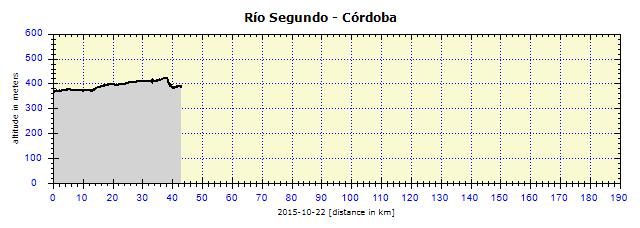
Nothing compares to the simple pleasure of a bike ride. J.F.Kennedy
Search this website
To Córdoba
Buenos Aires, Pilar, Solis, San Antonio de Areco, Arrecifes, Pergamino, Colón, Hughes, Melincué, Firmat, Corral de Bustos, Gral. Baldisera, Monte Buey, Ordoòez, La Laguna, Villa Maria, Oliva, Río Segundo, Córdoba
I visited everything of interest thoroughly in Buenos Aires. Considering the size of the city, I had been there long enough and it was time to move on.
Exiting the city was an experience which I would not long to have every day. I set the navigator to take me on to Road 8. I started on pedestrian paths in the center. The narrow streets had scarcely enough space for two cars, a bicycle with panniers would have no chance. The wide avenues in the center were packed with cars, cars in the side lanes were constantly driving out, parking or loading goods. The traffic was also very slow-moving, everyone was nervous and trying to push into all the available little spaces at all costs.
I ignored the GPS for the first part of my trip and, cycling on the pedestrian pathways, tried to reach the street with a dedicated cycle path. Only then did I head roughly in the right direction on the cycle paths in the city center. My fully loaded bicycle projected from the cycling lane, or rather the strip marked in the street. Cyclists going in the opposite direction skillfully avoided me. In this way, I managed to get out of the center and enter an area with wide streets without such insane traffic. There I could start using the GPS and slowly correct my position.
I was quite satisfied, perhaps far too soon. After 30 km, I even cycled for 2 km through more open landscape and through a large army base. The base was not specialized in pilot-free planes or controlled missiles, instead – considering the current times – it was specialized in cavalry.
After that, everything took a distinct turn for the worse. I cycled via a continuous stretch of satellite cities. Narrow road, literally crazy traffic, the shape of the verges was reminiscent of moon craters. The unsupported side lane was covered in deep water pools and mud from the previous night's storm. Every time I yielded to a truck was translated into dirtying my recently washed clothes even more. This ‘fun’ continued for 30 km.
After Pilar, 60 km later, I entered the open countryside. Whoa! After only one kilometer the road turned into a standard highway. There were no signs forbidding cyclists, yet when I had passed highway approaches close to B.A., there had always been signs forbidding pedestrians, bicycles and horse-drawn vehicles. I saw no sign, so continued on the highway. The wide, paved side lane was not even very cluttered, it was fine. Finally I had some time to complain about the strong wind, blowing mostly from 11 o'clock and sometimes from a tolerable 9 o'clock.
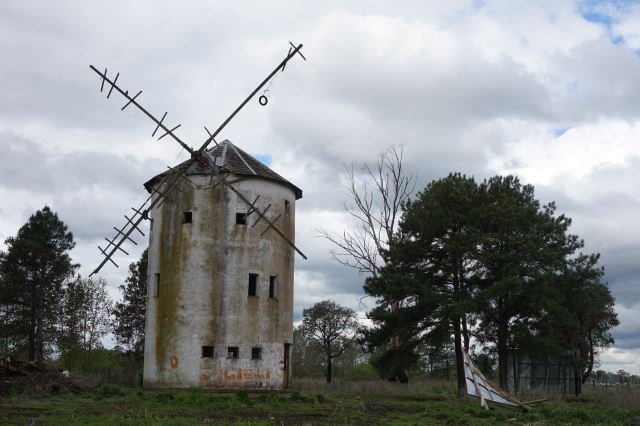
10 km W of Pilar: Ruined windmill
It transpired that I was probably allowed to cycle on the highway. After the tollgate, the police had a roadblock and were controlling cars, but totally ignored me. I was happy, but only for a few kilometers, after which the highway ended and the road turned into a two-directional one with an unpaved verge. I outsmarted it for several km by cycling on the partly built highway. Then I had no choice but to accept the adverse conditions. It meant a constant monitoring of the rear-view mirrors, spotting trucks, yielding on to the broken verge and back again on to the roadway when the road was clear. But I had to keep track of the front, too. Some cars overtook in such a manner that, if I did not yield to the side, they would have taken me on their hoods several km back towards B.A.
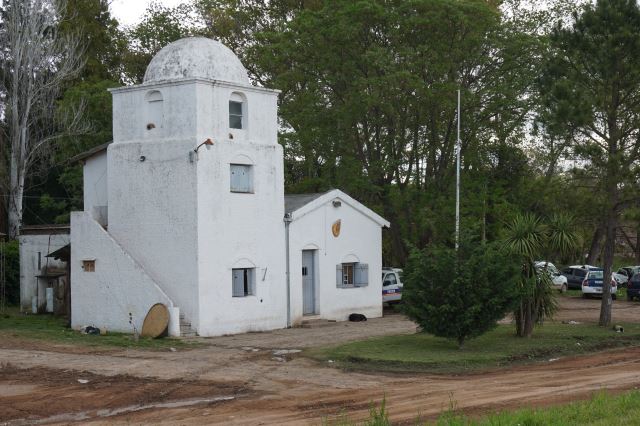
20 km W of Pilar: Stylish police station

20 km W of Pilar: I enjoyed cycling on the highway under construction
If it continued like that, I would have had to cycle on the left of the road, against the traffic. In that way, I would only need to monitor the traffic ahead of me. After 120 km, totally exhausted, I stopped in San Antonio De Areco. The tourist office was still open at 17:30 and provided me with a list of cheap accommodation, informing me that, at that specific time, there was no cheap accommodation available in the city.
A Typical Day
That day was a good illustration of my passion for traveling by bicycle. First I rode around uneventfully for 7 hours. Naturally, the wind was blowing, the verge would become a side lane in the next century and keeping track of the trucks was a question of survival. It would have been more exciting if one of the trucks had hit me, but I would not have survived that. The boring parts were much more preferable.

Urquize: Trucks did not give me much space
Blowing in the wind
As I said, totally boring for you, who are not a part of it. Nothing happened for seven hours. Then, suddenly, it all started. I stopped 5 km before Pergamino, my objective for that day. I turned on the GPS, it did not function. I took it apart, removed the batteries and, at the same moment, a police car stopped next to me and the policemen started to search me. The strong wind blew my SD card out of the GPS somewhere into the grassy overgrown ditch, but the policemen were not bothered. They wanted my documents, especially my passport. Losing the card containing the map and being bullied made me furious. I told them that I did not have a passport and handed them my international driving license. The passport was packed in a waterproof bag and to remove it would have been demanding. Surprisingly, they did not protest, they only wanted me to translate the details on the card such as name, surname, date of birth and number of the license. They mixed it all up anyway and, instead of the license number, wrote down my birth certificate number. It did not matter, they wrote it on a plain scrap of paper, so I expected them to throw it away at the next opportunity, unless they reused it for something more practical. After they had written on their paper, they became much friendlier and in the end we even shook hands like friends.
The police control left and I started searching for my SD card. You can imagine the size of it. Locating such a tiny piece of plastic in overgrown grass in a flooded ditch was comparable to a miracle. Unfortunately, there was no miracle. I gave up after half an hour, with the non-functioning GPS.
Pergamino was quite a large city. On my way to the center, I came across two modern and probably expensive hotels. I asked one amigo for económico accommodation. He sent me to a cheap hotel opposite the station. I checked in and had a long Spanish-English conversation with the hotel owner's son. To explain, I spoke in my terrible Spanish and he in his equally terrible English. When he learned that I was heading to Córdoba, he immediately informed me that in the Córdoba vicinity there were UFOs to be seen (he believed almost every day). He had already witnessed some several times. At first sight, he was a rocker, full of tattoos, about 30 years old and quite a handsome boy. We enjoyed a beer together and I asked him nicely whether he had been stoned when he was in Córdoba. He swore that he had not been. OK, I was to look out for a UFO in Córdoba and vicinity.
Then I went to the nearby supermercado to get a bite for dinner (and lunch, I eat only twice a day). The store was closed, no horario displayed. Two elderly ladies nearby informed me that it would open at cinco (at five, or in our language at 17:00), which was in two minutes. They were a mother and daughter, both called Martha. I was still wearing my cycling outfit, slightly dirty, splashed with mud. The daughter said that if she'd had her camera with her, she would have taken a photo of me. I had my camera, though, in my rucksack and took a photo. She protested that she was old and wrinkled, yet she seemed to be pleased with it anyway. I had no intention of pleasing her any further, so I purchased some food, walked through the city and back to the hotel to see if I could get my Garmin to work.

Pergamino: Mother Martha and daughter Martha
Garmin did not make it easy for me and I finally failed anyway. I thought I would manage to fix it. I loaded the correct map file on to an SD card, inserted it into the navigator and nothing happened. The map was not displayed. I tried another card, the same problem. I went to the city to buy a USB cable to connect the laptop to the Garmin, so as to access the files directly on the Garmin. No luck. In the end, I figured that Garmin was not able to read 32GB-sized cards.
The following morning, I waited until 09:00, the time when the local store selling cellphones was to open. As was the local norm, at 09:00 the door was still locked. I had to continue to the center, where I finally purchased a 4GB card. By the way, the store near hotel was not even open by 09:45. I loaded the map on to the new card, again no success. It seemed that the navigator was not able to read the files on the card. Due to these delays, I started pedaling again only at 10:00.

Colón: Airport entrance of local aviation club adorned with an old aircraft
Nature was kind to me. A fresh wind blew from behind, it was pleasant cycling with such assistance. Traffic on Road 8 was minimal and, most importantly, there were almost no trucks. It was apparent that it was a Saturday.
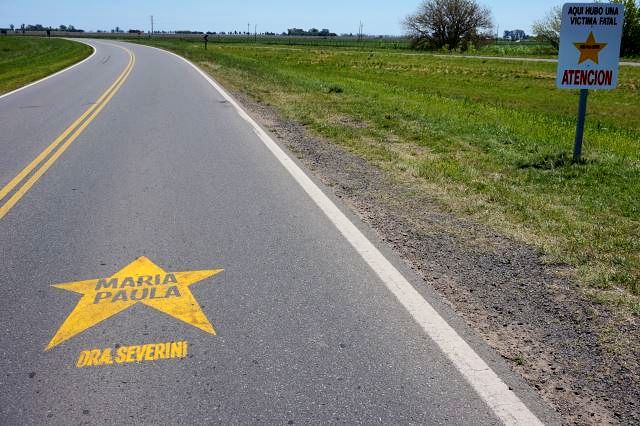
W of Colón: This is how sites on which fatal traffic accidents occurred are marked
After Colón city, there was the provincial border, which was rather obvious. Another improvement. The road had a great paved side lane in Santa Fé province, despite the speed-bumps, which could be avoided. I reached Hughes village. I had already cycled 85 km and at first planned to stay over there. I did not like the place, so I continued instead.
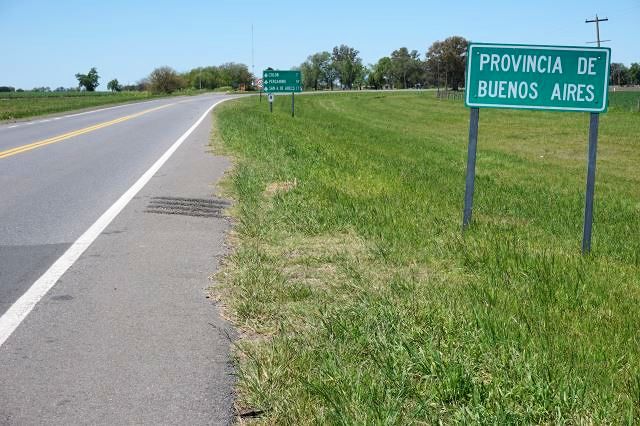
W of Colón: In Buenos Aires province, verges are left unpaved

W of Colón: A convenient verge appeared on the border of Santa Fe province
I left Road 8 and turned on to local Road 93. It is always better to cycle on a side road and to witness the daily life at close hand. There were 18 km to Melincué, according to the map. In practice, it became 30 km. The direct road was closed. I asked people if it was possible to cycle on it. It was not, the road had been flooded by the adjacent lagoon. I had to cycle through Labordeboy. The sides of the road were flooded. Several fishermen were taking advantage of it and fishing directly from the side lane. There were numerous birds everywhere, not at all bothered by the passing cars. However, my cycling disturbed them without exception and forced them to fly off a bit further.

Labordeboy: A flooded meadow
Miguel caught up with me in Labordeboy and we continued together to Melincué, where he lived. We talked during the whole trip. At a gas station in Melincué, he inquired about a hospedaje and guided me to one. It was curious when the lady gave me her business card with a phone number to call her, in case I got lost. The town was so well laid-out and tiny that it would be hard work to get lost there and would require a high dose of alcoholic intoxication to do so. It was a nice service to guests, though.
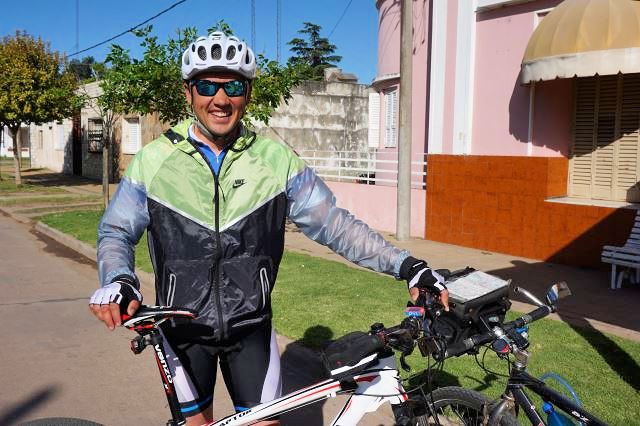
Melincué: I cycled 15 km with Miguel from Labordeboy to his home in Melincué, talking all the way, unfortunately only in Spanish
Thanks to the connection to the Internet, the GPS functioned again. At first, I ran a hard reset – one finger touching the left top corner of the display, while turning on the navigator. Then I loaded the map files for North America (purchased directly from Garmin) on to the card. I tested the GPS on Boston and everything worked. This meant that reading the card was not the issue. It was obvious that the problem lay in the data. I Googled and – spot-on – the problem was solved! The data files had to be stored in a Garmin folder. I saved them in the root file. Two minutes later, everything was again functioning as it had before the wind had blown the card out of my hands.
All in all, it was once again due to my own stupidity. Instead of changing the batteries in good time in a safe place, I had to do it in the road. I was simply lazy, hoping the batteries would last for a while. On the other hand, I had something to do for one whole day and had something to ponder about for the whole day.
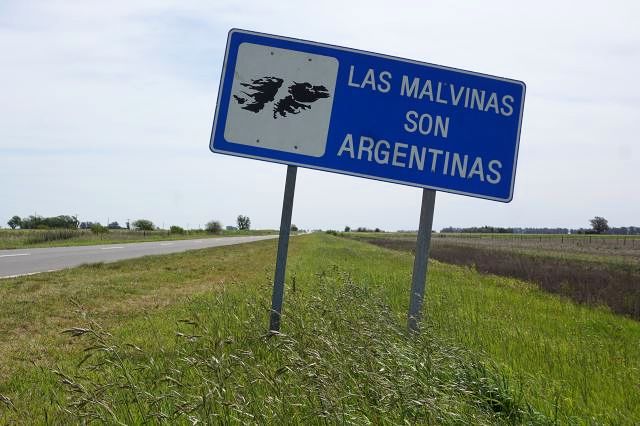
Near Chaòar Ladeado: 'Malvinas (Falklands) are Argentine' - here even on a traffic sign
I continued on the road in the middle of nowhere. The headwind was torturing me, those 23 km were challenging. Then the road turned 35 degrees to the West and the conditions were more comfortable. The wind was blowing from the side but, most importantly, was not slowing me down. Luckily I was wearing a scarf over my ears under the helmet, otherwise I would have probably ended up with an ear inflammation after so many hours of wind in it.
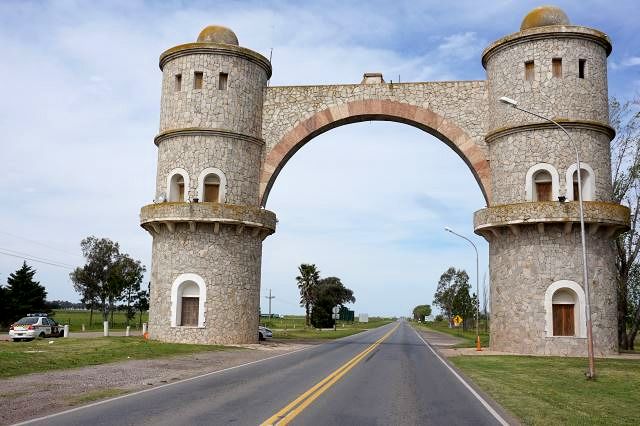
Corral de Bustos: City gateway
The landscape was not so interesting. It was flat pampas, mainly used for agriculture. Factories producing cereals were sometimes seen beside the road. All looked exactly the same, probably a standardized project. The sides of the road were often covered in water. It was probably not so throughout the whole year, as even long established trees were standing in water, as well as the cattle fences and access roads to estancias.
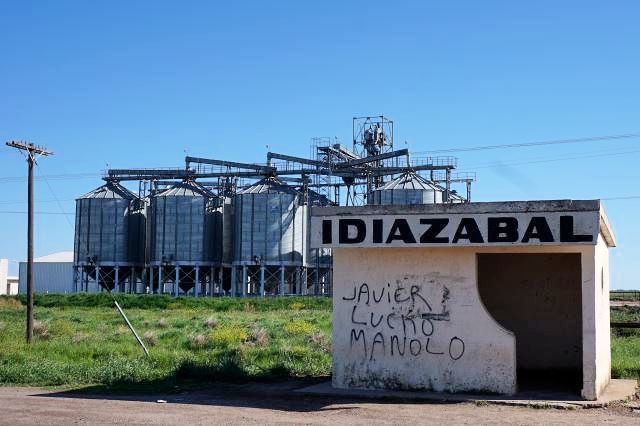
Idiazabal: Agricultural factory for cereals and other products
An unbelievable number of birds were bathing in that water, always scared off by my arrival. They were interesting to observe. Birds of prey were diving down towards the ground to catch some small mammals. Their wings were folded in such a way that, at the last moment before hitting the ground, they could rapidly slow down. I even saw a massive bird similar to a stork (about 1.2 m wingspan) which, when taking off, was pushed into the power lines by a gust of wind. He closed himself like an umbrella and, one meter above the ground, managed to open his wings and continue to fly off uninjured.
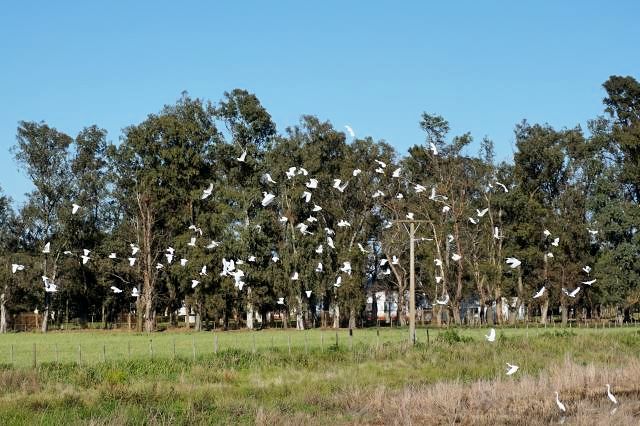
Near Ordoòez: My arrival on the road always caused a mass flight of birds, they did not mind cars

Near Ordoòez: 'Stork' in flight
I decided to sleep over in the fairly big town of Corral de Bustos. I was sent to a hotel which obviously was not one of the cheapest. So I continued to the square and neighboring streets and found another two, visibly scruffier, establishments. The owner of San Sebastian Hotel, evidently celebrating Sunday by being slightly under the influence of alcohol, immediately took care of me. He said he was fully booked, but gave me a family room, without any discussion, for the cheapest rate thus far – 150 pesos. However, nothing is free. I had to compensate for this by an hour-long conversation, during which he asked me everything possible and even gave me some trick questions (for example, how well I was doing on my old-age pension money). I battled a bit with my Spanish skills. However, he was not telling a lie. Some people arrived in the evening and the hotel was really full.

Corral de Bustos: Dilapidated station and factory dominate the center

Corral de Bustos: Old locomotive shed

Corral de Bustos: Busy casino on the square surprised me; there were only slot machines, no roulette or black jack
I asked for a restaurant recommendation. Parrilla was closed on Sundays, otherwise I would surely have gone there to fill myself up with meat. I waited until 21:00, when they started serving dinner, and ordered Milanesa Napolitana, a common meal there consisting of a beef schnitzel, baked with cheese slices and tomato on top. Together with salad and mashed potatoes, I ate my fill. Certainly good fuel for the following day's cycling.

Corral de Bustos: Local church on the square

Corral de Bustos: The statue is a landmark of the small town, with its back also already pretty rusty
Finally, I also oiled the chain and sprayed the SPD pedals, which were certainly needed. At over 3000 km, I would have to keep an eye on the chain, so as not to stretch it too much. I carry the gauge with me, only it is packed down somewhere deep in the box of tools.
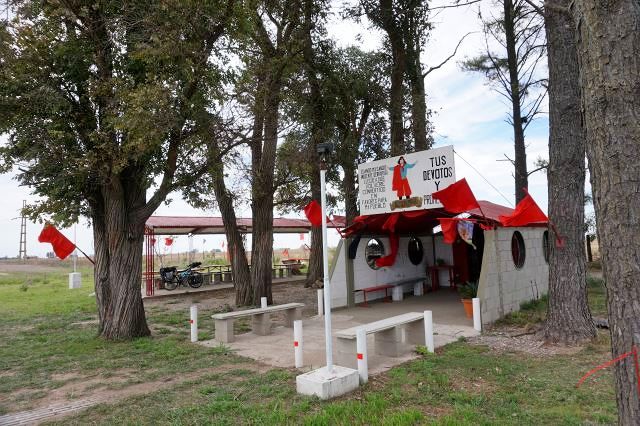
Junction at Inriville: 'Sanctuary' of Gauchito Gill supplemented with tables and benches for motorists' rest - a common sight here
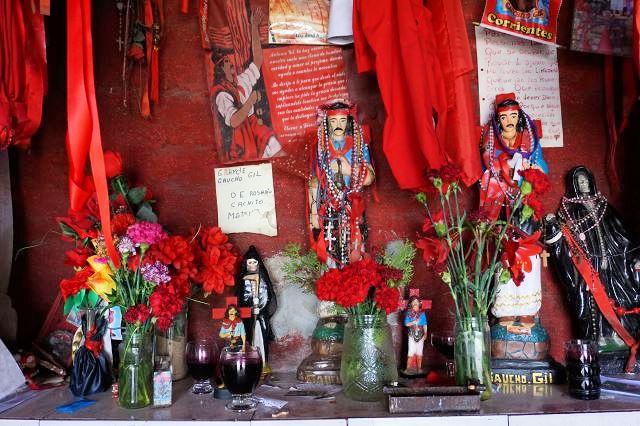
Junction at Inriville: The interior of the 'shrine' of Gauchito Gill
The first 10 kilometers on the following morning were windless. The weather changed and it seemed as if it would start to rain at any moment. I cycled to Colonia O Higgins, the route to an inland road was marked on the map. However, the road was flooded and I had to turn back. Then I turned 90 degrees to the North, meanwhile the wind started blowing and right into my face.
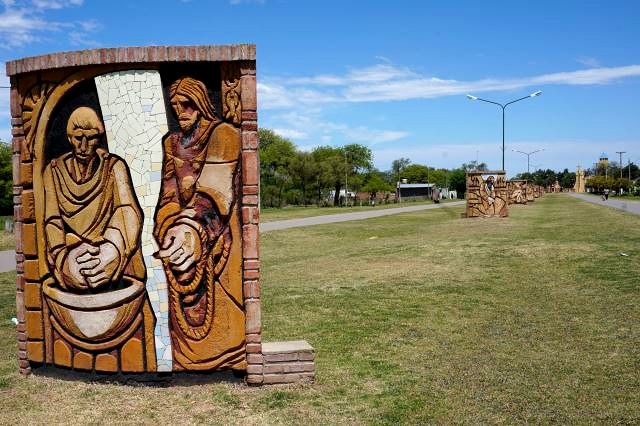
Saladillo: Modern Way of the Cross at village entrance
After another 40 km, I arrived at the crossroads close to Inriville. I could continue further northwards to the significantly bigger Marcos Juaréz, but I would constantly have to battle my way against the wind. I turned 90 degrees to the West and thus eliminated the wind. As a consequence, I slept over in a hole called Ordonez. It was cheap, though.
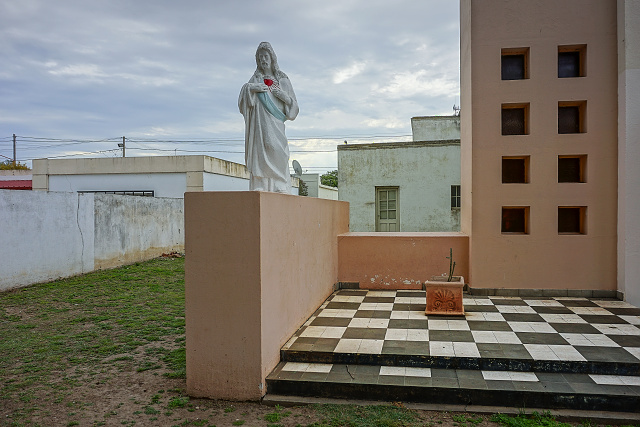
Ordoòez: In front of the church
The hospedaje owner appeared to be Japanese. The WiFi password was "Samuray2015", so it was clear to me and I started talking to her in Japanese. No reply. So I asked her directly whether she was Japanese. No way! She came from North Argentina. And what about the password, why "Samurai"? That was the name of her husband, who had been gone for several years. We, amateur linguists, sometimes have a difficult time.
It rained all out overnight, the sky was clear in the morning. The wind was strong, however. The change of weather came together with a change in wind direction. The day before it had blown from the East. That morning, it was from the South. It eagerly pushed me from the left, but I was not bothered. I knew that 40 km later, I would turn northwards and would have the storm behind me.

Near Ordoòez: Eternal wind made it difficult for my little flag
Close to Idiazabal, something like a motorbike moving slowly appeared in the distance. Soon I knew what it was – a long-distance cyclist. Only the 4th on my trip that year. I had already met the first three in Paraguay, on the first day after Asunción. Alain had already been on a trip for three years and planned to return home to France in six months. His bicycle was unbelievably loaded. For example, he was carrying a guitar, which he had purchased in Columbia, because it was cheap. Panniers, clothes, water bottles, three thermos flasks (!!!), camera, everything was very worn out. He probably did not have the best quality equipment. It was his first trip. Ortlieb panniers would still look good even after three years of travel. We talked for almost an hour, the encounter was exceedingly pleasant. What surprised me most was when he told me that he was a vegetarian, he would not eat even fish. What the hell was he doing in Argentina, the great meat-eating country?

Idiazabal: My humble load can not compete with Alain's
I started feeling tired. I decided to skip the usual 100 km goal and stop in a fairly large town – Villa Maria. As their only guest, I found accommodation in the local hostel, a terrible hole. They made their living from the pub attached to it. Luckily the sound did not reach my room. The town was pleasant, with several parks, the shopping mall in the city center opened in the evening. I enjoyed a bit of civilization after several days without it.

Villa Maria: Detail of building on the square
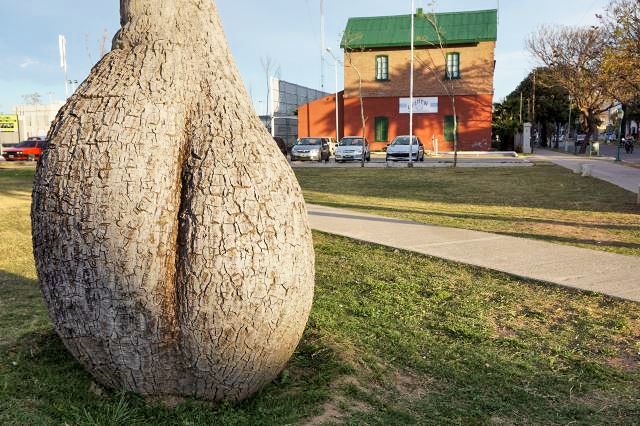
Villa Maria: Several Baobabs successfully growing in the center

Villa Maria: Footbridge
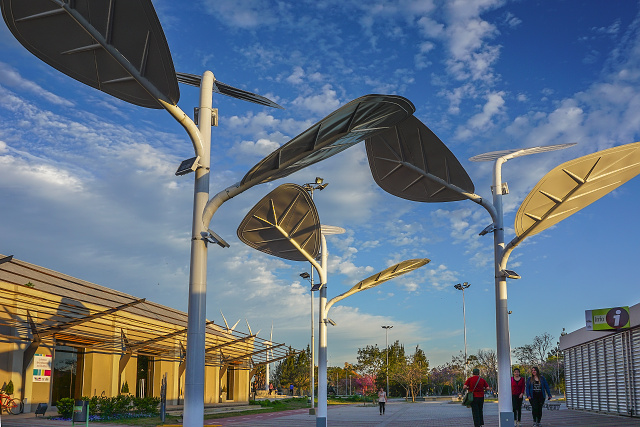
Villa Maria: Installation in front of Cultural Center
Contrary to my negative expectations, I slept really well and woke up at 07:30. I pumped the back tire and then even my belly. I made 6 eggs fried with onion, ate half of it and transferred the second half into a baguette together with tomatoes. I made a habit of eating something after 50-60 km. Instead of trying to find something en route, I prepared it from my breakfast. For sure, I was not losing any weight, thanks to my high consumption of white bread.

Villa Maria: Cathedral

Villa Maria: Cathedral – facade detail
I started my journey, but something did not feel right. I felt strange. When I exited the city, I realized what it was – no wind! Literally, not even a straw was moving. This miracle lasted until 12:00 and then a mild headwind started to fan my sweating temples. Spring arrived in full force and the temperature reached 40 degrees in the sun.

Oliva: Malvinas War Museum - A-4 Skyhawk in background
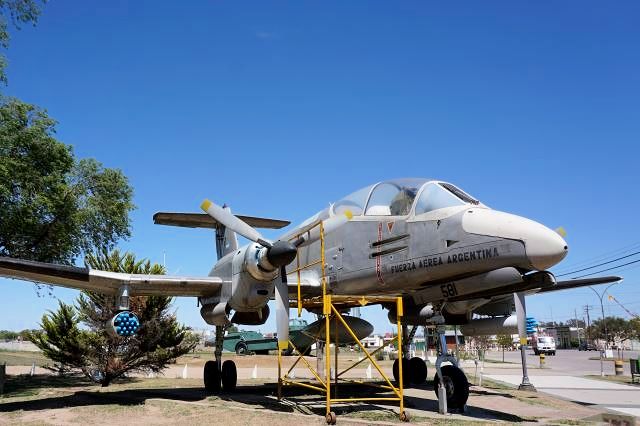
Oliva: Malvinas War Museum - IA-58 Pucara - aircraft designed in Argentina
The Malvinas War Museum is situated in the park of Oliva City. They lost badly in the war, so I wondered why they publicly reminded themselves of it. However, Malvinas (the Falkland Islands) is still a hot topic there, as well as a great frustration. I reached that conclusion based on the number of signs claiming that "Malvinas belong to Argentina", regardless of the reality. Almost every town has a monument and a street bearing the name of Argentinian Malvinas.

Oliva: Malvinas War Museum - English Canberra Mk62 bomber fought on the Argentinian side
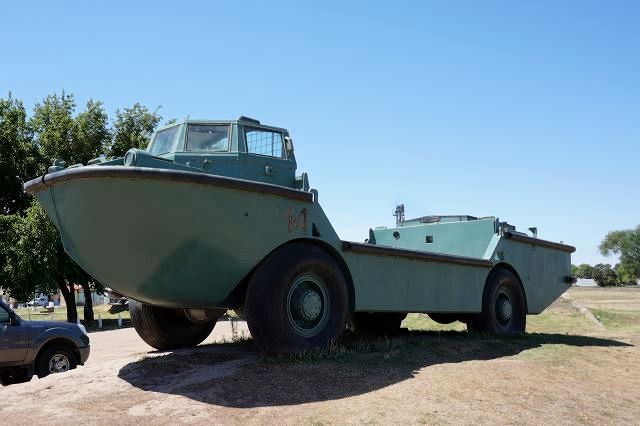
Oliva: Malvinas War Museum - amphibious landing vehicle
Those with a knowledge of my aviation past would have guessed that I was most interested in the aircraft displayed in the Museum. The biggest curiosity I found was the Argentinian Pulcara. I was surprised that, at that time already, the historical English Canberra bombers were used by the Argentinian side.
I kept the last 40 km to Córdoba for the following day, so stopped over in Río Segundo and searched for a place to stay. The only, evidently cheap, hotel was beside Road 9. I did not like the town itself, so decided to continue another 18 km to Toledo City. I stopped at the crossroads and had already decided which way to go, when at the same moment, a cyclist arrived whom I had encountered coming from the opposite direction several hours earlier. He informed me that there was no accommodation in Toledo City and everyone rather continued on to Córdoba. He offered to guide me to the only local option available there. I knew that one already, we arrived there and the lady informed us that she was fully booked. He told her that I was his friend. That made all the difference and a room became available, even though at the very back in the annex. By the way, she was really fully booked, I later witnessed her refusing other customers.

Río Segundo: Amigo - 4 years younger than me - took me to a small hotel and persuaded the owner to accommodate me
I had time, as I had already cycled through the city. I purchased something for dinner and, instead of strolling outside, changed the chain, checked that all the screws were tight, loosened and greased the pedals and seat post, so that they would not rust. I shaved my head, this time successfully without any flow of blood, and trimmed my beard a little to ease the decision hotel owners had to make when judging whether I was a decent guest.
The route to Córdoba was amazing, due only to the fact that there was almost no wind. The GPS took me reliably through the city, allowing me to focus on the road in the busy and, in some places, wild traffic. I arrived on San Martín Square at 11:30, sat on a bench and ate a baguette I had prepared in the morning. I found accommodation at exactly midday in a hostel one block from the square, which I had reserved. The hostel was cheap, a room cost only 150 pesos per night. I had expected it to be awful. Although the room was tiny, it was clean and furnished with a cupboard into which I could put all my gear and avoid having it piled up on the floor.

Córdoba: View from the roof of the hostel in Gral Alvear Street
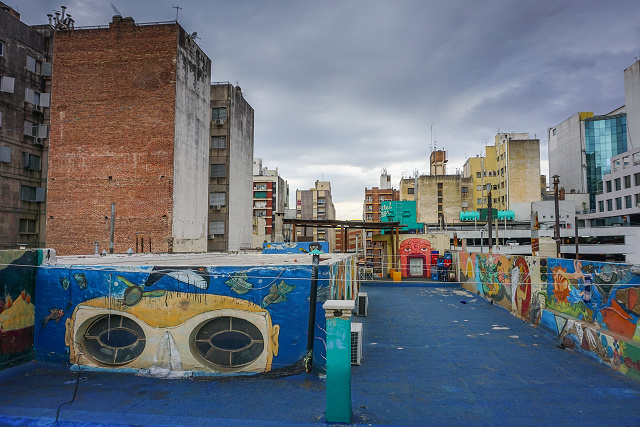
Córdoba: Hostel roof is also designed for drying laundry
Córdoba
I liked the city more than Buenos Aires. Although the historical part was extensive, it was also rather compact. Historical sites were close to each other, in fact they were connected to each other. There were also several pedestrian shopping streets, between which always a few old churches were hidden. Always something to look at. All the significant sites dated back to colonial times, mainly from the time when the region was developed by the Jesuits. They were so successful that the Spanish King recalled them – I already mentioned that in the section I wrote on Paraguay.

Córdoba: Panoráma Plaza San Martín – (left) Cathedral, (right) Cabildo

Córdoba: Plaza San Martin

Córdoba: Iglesia Catedral
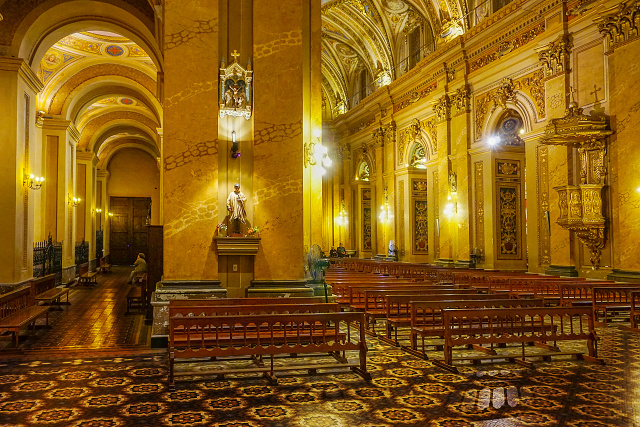
Córdoba: Iglesia Catedral - interior
The extensive San Martín Square has two important historical sites. The first is the Cathedral dating back to 1577. Its construction took two whole centuries. It was started by the Jesuits, then continued by the Franciscans. Due to that, the architecture is not pure in style, but its beauty is not marred by this fact. The second site is the Cabildo, a huge public building from colonial times, housing a Museum and (for me, very important), a tourist information office, where I picked up a city map and received several brochures in both Spanish and English. The building has a yard which I viewed with genuine delight. During my long walks around the city, I sometimes returned to the Cabildo, as public washrooms are also situated there. Naturally free of charge – I was in South America, not in some developed European country, right?!
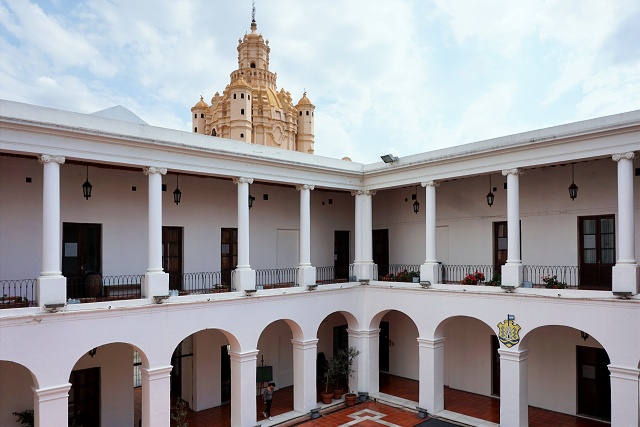
Córdoba: Cabildo Historico - inner courtyard
The most prized site is the extensive Jesuit block (Manzana Jesuítica) which was listed as a UNESCO memorial in 2000. Iglesia de la Compaòía de Jesús, a Jesuit church whose construction began in 1645 and continued for 26 years, especially attracts a lot of attention. The cedar roof in the shape of an inverted ship's hull is most remarkable. The choice for that motif can be understood when learning that the architect, Lemaire, was originally a shipbuilder. The Baroque altar is also awe-inspiring. It appears to be carved from marble, yet was made from Paraguayan cedar imported from the Misiones province (I also cycled through that region in that year).
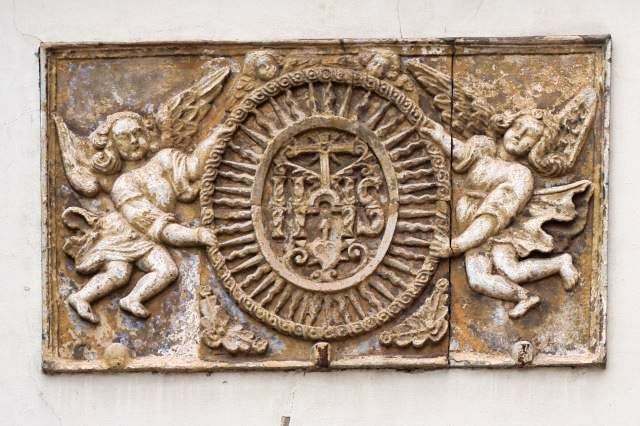
Córdoba: Manzana Jezuítica - emblem

Córdoba: Manzana Jesuítica - Iglesia de la Companía del Jesús
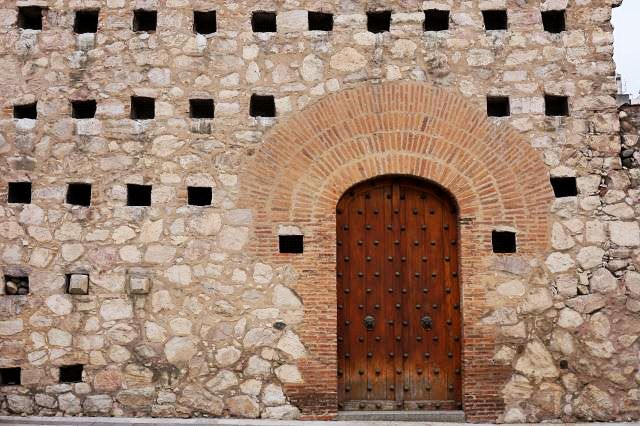
Córdoba: Manzana Jesuítica - Iglesia de la Companía del Jesús - the walls are original from 1645

Córdoba: Manzana Jesuítica - Iglesia de la Companía del Jesús - wooden altar looks like carved marble
The first Argentinian university - Univesidad Nacional de Córdoba – is also in the Jesuit block. One could see many students in the area of the building, the University was still open. The courtyard was freely accessible, the interior only with a guide. The one hour tour in English was very interesting. We got to see the parts of the church which were not generally accessible, as well as the extensive library, a collection of old maps of South America, as well as the original ceremonial hall, which served for the inauguration of new Ph.D. students (it was later moved to the new part of the University). All that for the round sum of 10 pesos.
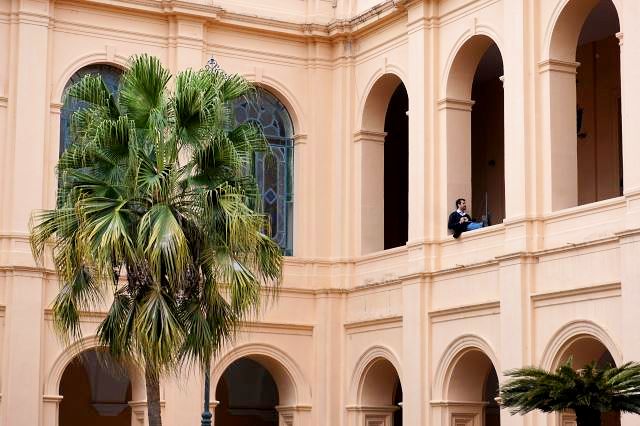
Córdoba: Manzana Jezuítica - Universidad Nacional de Córdoba - the first university in Argentina still serves its purpose
I was most taken by the Capilla Doméstica - a chapel accessible from Caseros Street near the Jesuit block. This small chapel was completed in 1644; the richly decorated ceiling is especially amazing. The ceiling is made from cowskin, stretched over a wooden construction and painted with a pigment, the main ingredient of which is cooked bones.

Córdoba: Manzana Jezuítica - Capilla Doméstica - small chapel with magnificent ceiling and altar
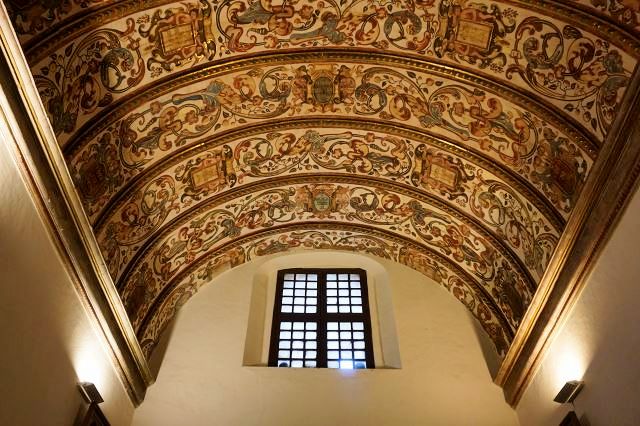
Córdoba: Manzana Jezuítica - Capilla Doméstica - brightly painted ceiling

Córdoba: Manzana Jezuítica - Capilla Doméstica - detail
I also visited San Alberto Museum, housed in a building where Carmalite nuns were living. For that reason, every visitor received a guide (included in the price of 5 pesos), who promptly walked him/her through in such a way that the inhabitants would not be disturbed. The earlier local burying style was interesting – the body was lowered down into a crypt and covered with earth, in order to decay faster. The crypt was then closed with a wooden lid and the room above it was used for daily living. This method was forbidden at the beginning of the 20th century and bodies had to be transported to the city graveyard.
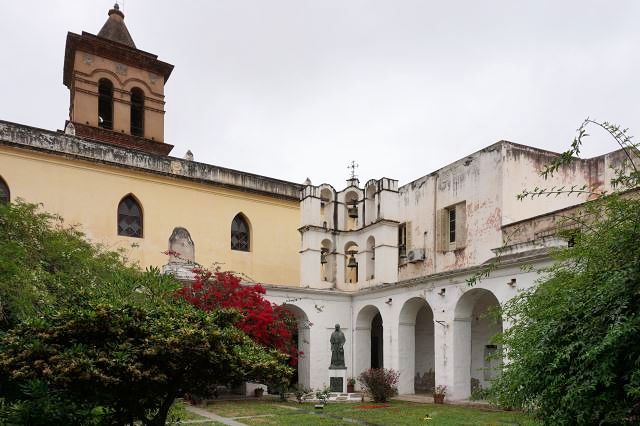
Córdoba: Hermanas Carmelitas de Santa Teresa de Jesus - atrium

Córdoba: Hermanas Carmelitas de Santa Teresa de Jesus – nuns elect the Mother Superior of the order here
The Jesuit Crypt (Cripta Jesuítica) from the 18th century was filled up during a radical city construction and forgotten. It was later rediscovered in 1989 by Telecom workers who were laying a phone cable. The city restored it and today these underground rooms serve for exhibitions and concerts. I visited several other churches and started mixing them all up. I had to start writing in a notebook where and what I had photographed.

Córdoba: Cripta Jesuítica - the crypt accidentally discovered in 1989 now serves as a cultural center

Córdoba: Basílica Santo Domingo - main tower

Córdoba: Basílica Santo Domingo - the nave

Córdoba: Monasterio San José - wall decoration

Córdoba: Monasterio San José - adjacent yard
Archivo Provincial de la Memoria
You might have become bored with all the churches by now, but I enjoyed them. However, there were also other sights to be seen. The Museum of Memory reflects on the time of terror during the military dictatorship of El Proceso between 1976 and 1983. The Museum is located in the area of a stockade prison where political objectors were held, interrogated and tortured. The building itself is in a catastrophic state (probably the same state as it was in during the period of terror), which intensifies the horrifying impression, evoking an image of the evil acts carried out by the D2 secret police. During that time, thousands of people disappeared without a trace, their photos are displayed in the Museum itself and its vicinity.

Córdoba: Alley with portraits of people who disappeared during the military dictatorship

Córdoba: Archivo Provincial de la Memoria - dungeon where interrogations were conducted

Córdoba: Archivo Provincial de la Memoria - backyard of prison and torture chambers
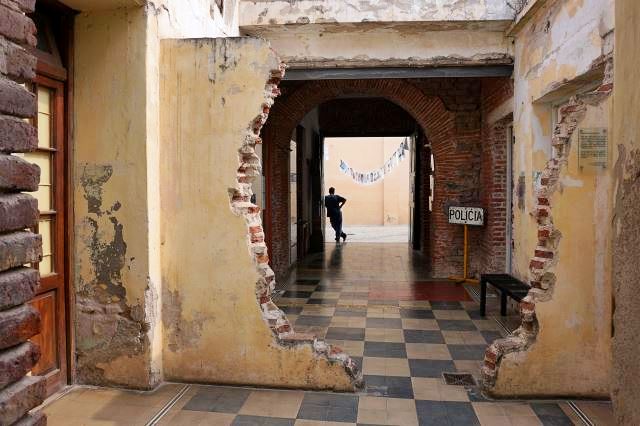
Córdoba: Archivo Provincial de la Memoria – street view from the Museum
Communist Demonstration
Red flags were fluttering in front of the Cathedral in the evening. I was fascinated by the contrast of the red star against the Cathedral background and took several photos of it. One of the protest organizers, a young woman, was sent to me to ask if I was from the press. She could speak English and naturally we ended up having a political discussion. I tried to explain to her that the communist ideology is nonsensical and that I had experienced it at first hand for 40 years of my life. She brought up the fact of human equality. I asked her to name the countries where communism actually worked. She named Cuba. So I asked her what kind of cars were used by Cuban laborers and what kind by Americans. She said that cars were not important. Simply, the idea was right, only people made it fail. I asked her, then if that was the case, should people be changed? She nodded excitedly. She behaved well, like a comrade. Finally, she hugged me firmly and gave me two warm kisses. She had probably copied them from Husák and Brezhnev.

Córdoba: Communist demonstration in front of the Cathedral
Nueva Córdoba
The suburb of Nueva Córdoba is South of the historical center. Tall buildings, wide avenues, quality cycle paths. The Paseo del Buen Pastor cultural center is in a desecrated church. A very pleasant place, surrounded by a park, with many modern statues and installations. During my visit, they were hosting a photographic exhibition on the Malvinas (Falklands) War and a visitor who did not know the history might have got the impression that Argentina had won the war.

Nueva Córdoba: Pleasant cycle path

Nueva Córdoba: Paseo del Buen Pastor - statue in front of the Cultural Center

Nueva Córdoba: Paseo del Buen Pastor - water sculpture

Nueva Córdoba: Paseo del Buen Pastor - park with wrapped tree trunks
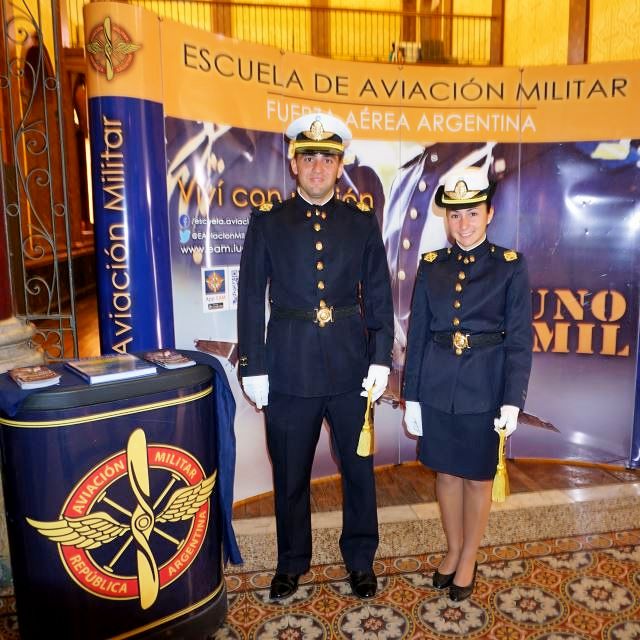
Nueva Córdoba: Recruiters for Air Force school
Opposite the cultural center is the ornamental Gothic Revival church - Iglesia del Sagrado Corazón de los Padres Capuchines. My attention was caught by the colorful and very detailed facade, together with the mural of statues of Atlas supporting individual saints.

Nueva Córdoba: Iglesia del Sagrado Corazón de los Padres Capuchines - purple blossoms on trees in front of church

Nueva Córdoba: Iglesia del Sagrado Corazón de los Padres Capuchines - neo-Gothic church portal
I dedicated the last day in Córdoba to art. Ferrara Palace was built in 1914 in the Louis XVI style. The building itself is stunning, built in a pure style and worth visiting in itself. It houses a museum and art gallery, which increases its value as well as its charm for visitors. Some rooms have been preserved, partly furnished with original furniture, the rest serve as a gallery. An elevator is built in a very decent way and the otherwise ugly black stairway leading to the top floor is also well placed, not at all disturbing the spacious area of the building. By the way, a narrow, dark staircase is a recipe for a broken nose.

Nueva Córdoba: Palacio Ferryera - view of the building

Nueva Córdoba: Palacio Ferryera - impressive hall with main staircase
The art collections did not excite me too much. They were works by Argentinian artists whom I did not know and had a hard time finding interesting. Nevertheless, the beautiful space made it an uplifting experience. Moreover, the Palace has nicely diffused light, a truly beautiful atmosphere.

Nueva Córdoba: Palacio Ferryera - concrete statue of a woman - but beware, it is not Evita Perón
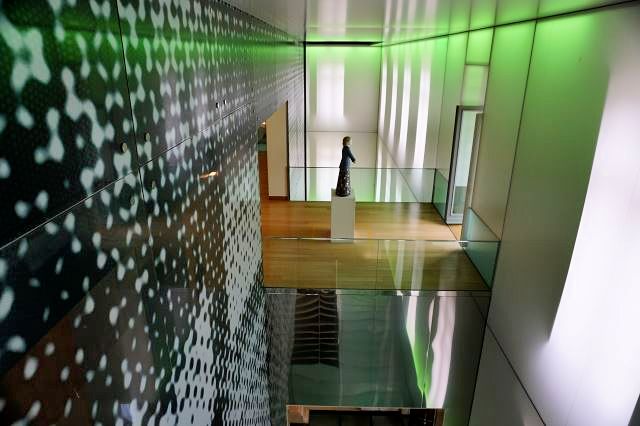
Nueva Córdoba: Palacio Ferryera - 'bridge' leading to veranda on the first floor
All that, together with the first beer of the day (note, I drank it after midday), motivated me to start taking (this time really) artistic photos. I could already picture my photographic mentors, the Vlèek brothers, rolling in laughter.

Nueva Córdoba: Palacio Ferryera - I started creating Art – object number 1 is a hydrant with a hose

Nueva Córdoba: Palacio Ferryera - I started creating Art – object number 2 is a sofa
I walked through spacious Sarmiento Park and once again took pleasure in viewing my favorite churches. I purchased food supplies for my future travels, and stuffed myself with meat in a food hall selling food by weight.
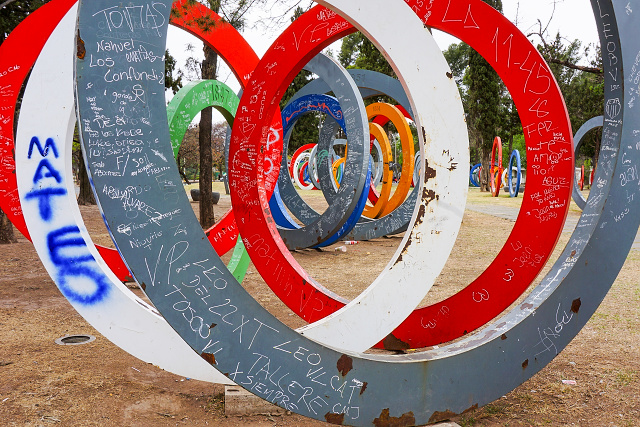
Nueva Córdoba: In Sarmiento Park
In the evening, I took a short stroll to a renowned local artists’ market. I spent several hours there, music, clowns, photographic gallery, many stalls and people - a great relaxing American atmosphere. I purchased pan relleno (stuffed bread) from some grannies, which was enough for my dinner, considering my plentiful lunch.
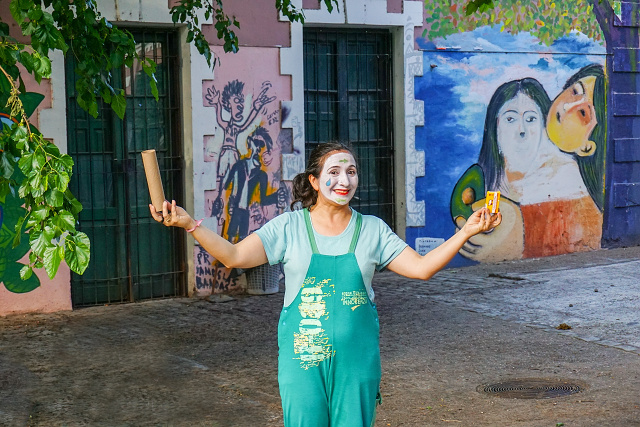
Córdoba: Feria de Artesanias - magician whose only audience I was – she was performing in the wrong place

Córdoba: Feria de Artesanias - girls preparing for a performance with a bird - one with a creaking violin and the second operating an ostrich puppet
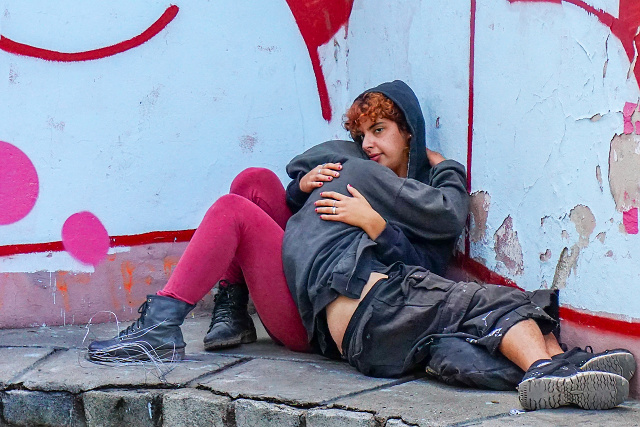
Córdoba: Feria de Artesanias - sometimes people simply smoke too much

Córdoba: Feria de Artesanias – ceramics are popular articles at art markets

Córdoba: Feria de Artesanias - when the sun shines, one immediately feels happier
How to Spot that an Election is Imminent
The weather got warmer and I had changed to cycling in my shorts without leg warmers already before my arrival in Córdoba. My shorts had almost fallen apart, I no longer dared to wash them. The weather then changed again in Córdoba and became very cold. That year I packed very modestly, no sweater, gloves or hat. I had normally never used them on my previous trips anyway. So I arrived at my usual dilemma, whether to purchase a sweater or liquor. In the morning, I tried fighting the cold by buying a sweater, but in the general cheap stores they only had acrylic ones and I find those unpleasant on my body. The stores with branded goods were better supplied, but the prices greatly exceeded the prices back home in the Czech Republic. This was not the case only for the trade-marked textiles. For example, my Sony A6000 camera would have cost me 2.5x more than back home.

Córdoba: Feria de Artesanias - painting and mosaic on a wall

Córdoba: Feria de Artesanias - adhesive coated metal fence
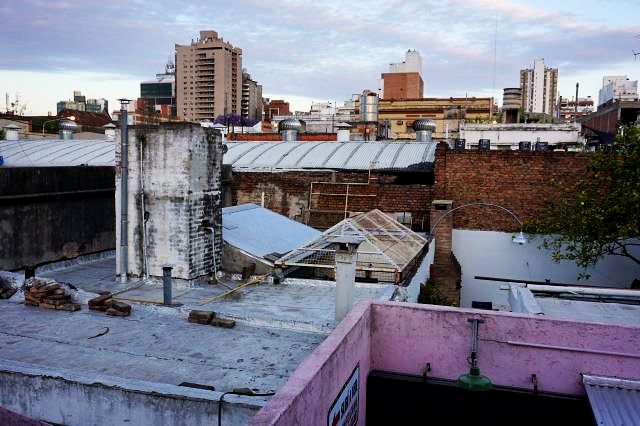
Córdoba: Feria de Artesanias - rooftops at dusk
No luck with the sweater, next was the liquor, which was certainly cheaper than back home, but often sold in a minimum of one-liter bottles. I did not fancy carrying one liter of liquor with me. I was pondering over this while standing in a supermarket, when an employee approached me and said that it was my last chance. And before I realized what he meant, he started taping over the shelf with all kinds of alcohol including the beer. It was 20:00 and because on the following day, Sunday 25th October, the presidential and parliamentarian elections would take place, any sale of alcohol was forbidden for 24 hours, ensuring that citizens would not make the wrong decisions, as they had always done in the past. You see how it ended: neither sweater nor alcohol and I could not even vote there.
Finally, some photos of the city.
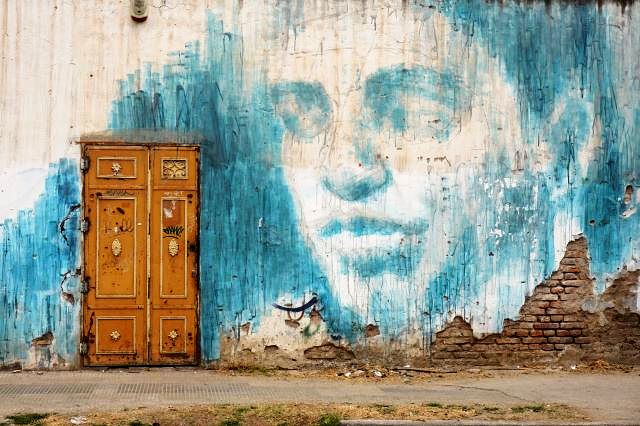
Córdoba - Guemes: Mural in a working class neighborhood

Córdoba: Galeria Jardin - housing the nearest laundromat
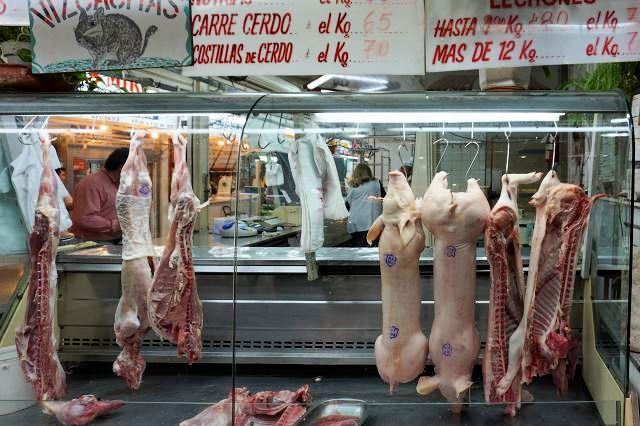
Córdoba: Pigs waiting for a buyer in the marketplace
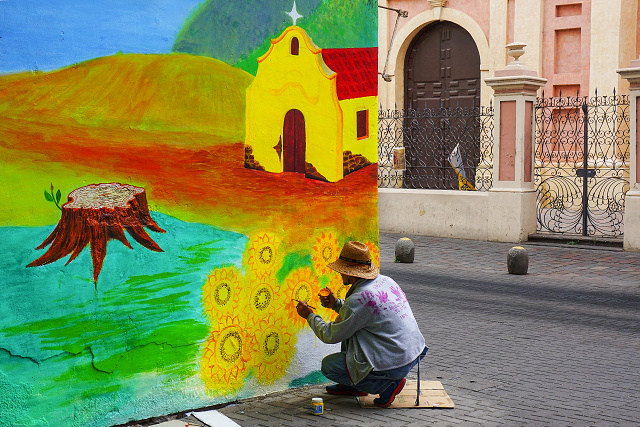
Córdoba: Artist finishing a wall painting
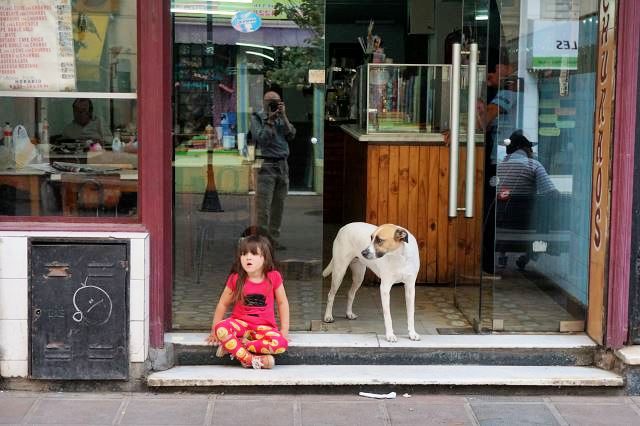
Córdoba: Store front

Córdoba: Young man playing great blues and having a good time
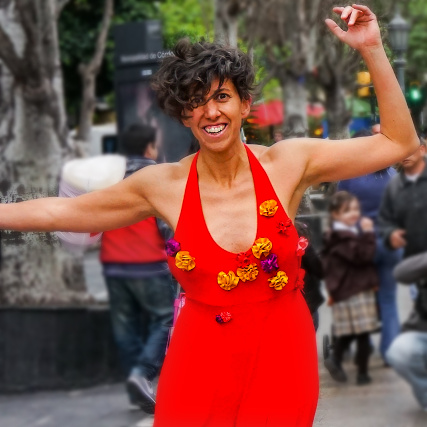
Córdoba: Transvestite showing off in pedestrian zone








